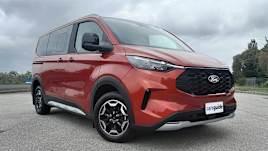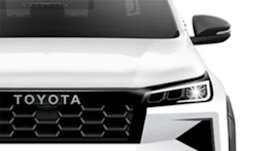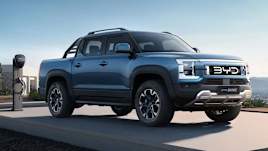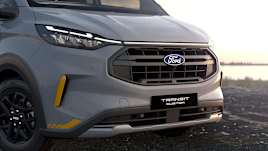Ford Tourneo Custom Pricing & Specs
The price range for the Ford Tourneo Custom varies based on the trim level you choose. Starting at $65,990 and going to $71,990 for the latest year the model was manufactured. The model range is available in the following body types starting from the engine/transmission specs shown below.
Cavernous is the word here. The Transit Custom upon which the Tourneo is based might be a mid-sized cargo van, but it makes for a vast people-mover. The whole layout is clever, too, thanks to the flexibility of the rear seating and touches like dual side doors (automatic) and loads of storage nooks and cubbies. Rear seat players aren't forgotten, either, and there are climate controls for the second row and air vents and reading lights for both back rows.
The Tourneo offers eight seats, each one a comfy, bucket-style perch rather than a simple bench seat for the second and third rows. The magic is in the way the seats can be slid along the length of the cabin, the seconds seats twirled 180 degrees to form a loungeroom, or even removed altogether to take the Tourneo back to its vanlife roots. The front seats are far enough apart for the cabin to be walk-through and they're also heated and cooled and the driver's chair is 10-way electrically adjustable.
Ford Tourneo Custom Colours
Ford Tourneo Custom Boot Space
Even with all seats occupied, there's a fair bit of luggage space in the back of the Tourneo. It's a high and wide space, too, not just deep, although the tailgate is huge and requires some respect when opening. With every seat occupied, there's 672 litres of space with the rear row in its rearmost position, and anything up to 4683 litres with both rear rows removed and stowed at home. In between, there's a layout for every combination of people and luggage.
Ford Tourneo Custom Towing Capacity
The Ford Tourneo Custom has maximum towing capacity of 2500kg for the latest model available.
Ford Tourneo Custom Fuel consumption
The Ford Tourneo Custom is available in a number of variants and body types that are powered by Diesel fuel type(s)
*Combined fuel consumption
Every Tourneo gets plenty of standard kit that is sometimes optional on other vehicles. That includes the heated and cooled front seats and the 10-way adjustable drivers seat. Wheels are 17-inch alloys and the cabin features both a central info screen as well as a 12-inch screen for the driver's information. There's keyless entry and start and, if you spend the extra on the flagship version, there's also a 360-degree camera system. A panoramic sunroof is a nice touch, but is only available on the up-spec variant and then doesn't open.
The 2.0-litre four-cylinder turbo-diesel engine makes a handy 125kW of power and and even handier 390Nm of torque. It's not a sporty engine, but it does offer a seemless supply of Newton-metres anywhere from idle onwards. It's smooth and very quiet when cruising, too, and is nicely matched to the eight-speed automatic transmission. A column-mounted shifter frees up cabin space between the front seats. The Tourneo is front-wheel drive.
Ford Tourneo Custom Wheel Size
The Ford Tourneo Custom has a number of different wheel and tyre options. When it comes to tyres, these range from 215x60 R17C for Wagon in 2025 with a wheel size that spans from 6.5x17 inches.
Hardly a priority here, and the turbo-diesel is really tuned for flexibility rather than outright performance. Figure on a 0-100km/h time of about 10 seconds which is more than swift enough.
The standard 70-litre fuel tank should take you around 800km between fills based on our real-world findings. The official combined fuel consumption figure is 7.4 litres per 100km, but we reckon around 8.5 litres is a better guess. You'll also need to add AdBlue every few thousand kilometres.













